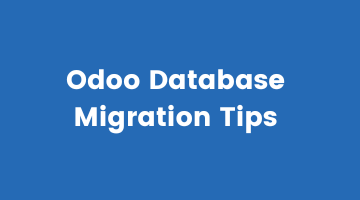Odoo Database Migration Tips

Odoo is a powerful, open source business application platform. But with great power comes great responsibility – namely, the responsibility to maintain and upgrade your Odoo installation as new versions are released.
One of the most challenging aspects of keeping your Odoo installation up-to-date is migrating your database from one version to the next. This can be a daunting task, especially if you have a large and complex database.
Fortunately, there are some things you can do to make the process simpler and less stressful. In this blog post, we’ll share some tips on how to successfully migrate your Odoo database.
Odoo Data Migration
There are many factors to consider when migrating data to a new database, but with careful planning and execution, the process can be relatively painless. Here are a few tips to help make your Odoo database migration go as smoothly as possible:
- Prepare a list of your objectives for the migration. What data do you need to migrate, and why? This will help you determine the best approach for your specific need.
- Estimate the size of your data. How much data do you need to migrate? This will help you determine the most appropriate method for transferring your data.
- Choose the right tools for the job. There are many options available for data migration. Do some research to find the best method for your needs.
- Test, test, test. Before you go live with your new database, be sure to thoroughly test the migrated data to ensure everything was transferred correctly into the new system.
- Have a plan B. No matter how well you plan and execute your migration, there is always a chance something could go wrong. Be prepared with a backup plan in case something does go awry.
By following these tips, you can ensure a successful data migration of Odoo
Preparation for Data Migration
One of the most important aspects of migrating to a new database is preparing your data for the move. This means ensuring that all of your data is properly formatted and organized so that it can be easily transferred to the new system. To do this, you’ll need to export your data from its current location and then import it into the new database.
There are a few different ways to export data, but the most common is to use a CSV (comma-separated values) file. This type of file can be opened in most spreadsheet programs, making it easy to view and edit your data. Once you have your data exported, you’ll need to import it into the new Odoo database.
Fortunately, Odoo makes it easy to import data from a CSV file. You can simply go to the “Import” menu and select “CSV.” From there, you’ll be able to choose the file you want to import and specify how you want the data to be imported. After that, it’s just a matter of waiting for the process to finish and your data will be migrated over!
Steps in Odoo Data Migration
Planning : You need to have a clear understanding of your data and how you want it to be structured in the new system. This is the most important step as it will determine the success of your entire migration.
Preparation : Once you have a plan, you need to prepare your data for migration. This may involve cleaning up old data, exporting data from your current system, and setting up import mapping in the new system.
Execution : This is where you actually migrate the data from one system to the other. Depending on the size and complexity of your data, this process can be simple or complex.
Testing : After your data has been migrated, it’s important to test everything to make sure everything was migrated correctly and that there are no errors.
Post-Migration : Once everything has been tested and is working correctly, you can finalize your migration by doing things like updating entries and redirecting old URLs to the new system.
Prerequisites for migration
Plan Ahead
The first important tip is to plan ahead. Don’t wait until the last minute to start thinking about your migration. Begin planning as soon as you know that a new version of Odoo is going to be released.
This will give you time to assess your current database, identify any potential issues that could arise during the migration, and develop a plan to address them. It will also allow you to test the migration process on a smaller scale before attempting it on your live database.
After migrating data
Assuming you’ve followed all the tips in the article about migrating your database to Odoo, you should now have a pretty good understanding of how to do it. However, there are a few more things to keep in mind after you’ve completed the migration.
First and foremost, it’s important to make sure that all of your data is backed up. Even if you’re confident in your ability to migrate the data without any issues, it’s always better to be safe. Make sure you have a backup of both your old database and your new Odoo database, just in case something goes wrong.
Secondly, you need to think about how you’re going to keep your data synchronized between the two databases. If you’re not careful, it’s easy for data to get out of sync, which can cause all sorts of problems. There are a few different ways to approach this problem, so take some time to research the options and choose the one that best suits your needs.
Finally, don’t forget to test ! Once you’ve migrated your data and synchronized it between the two databases, it’s critical that you test everything thoroughly to make sure everything is working as it should.
